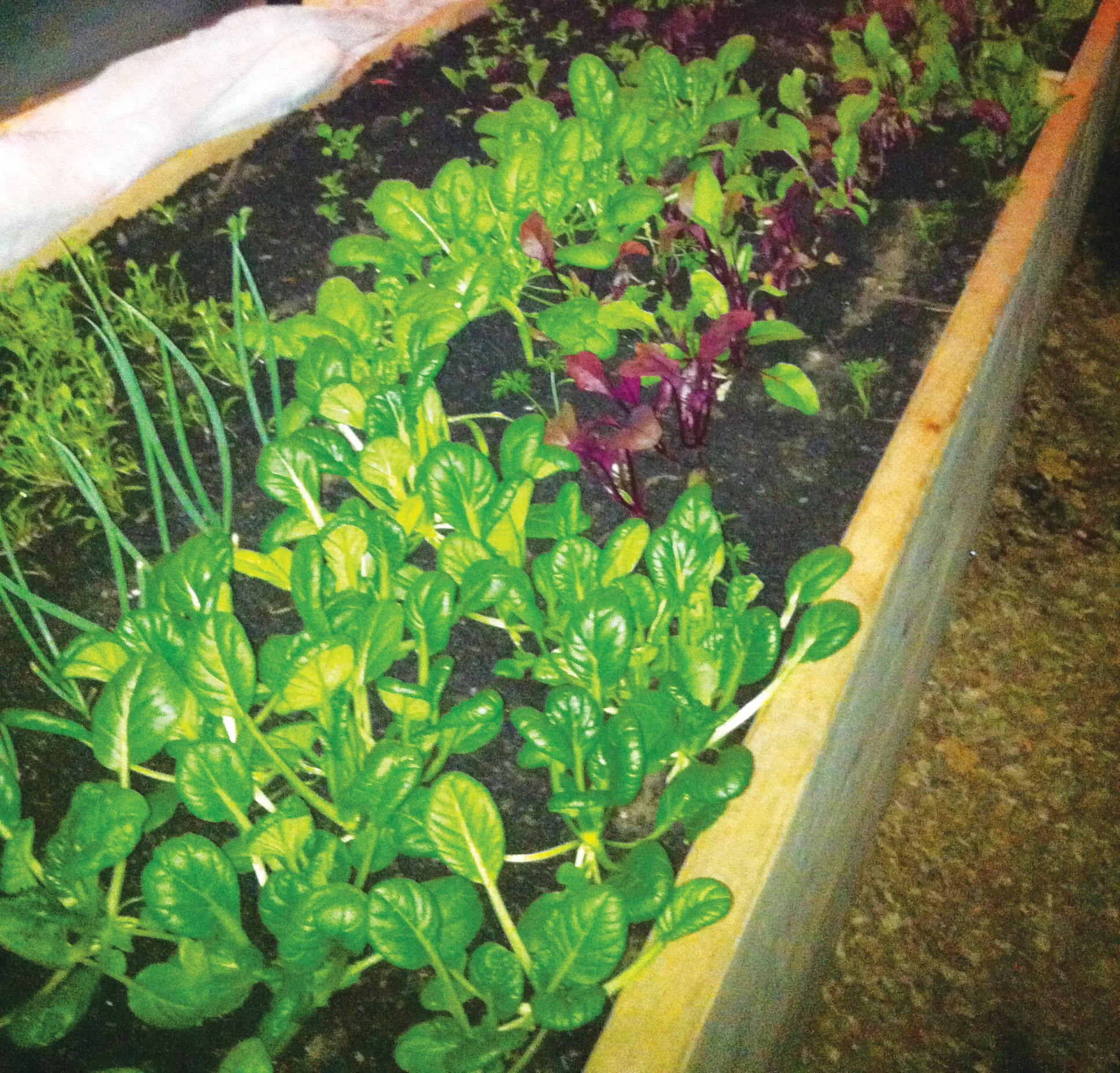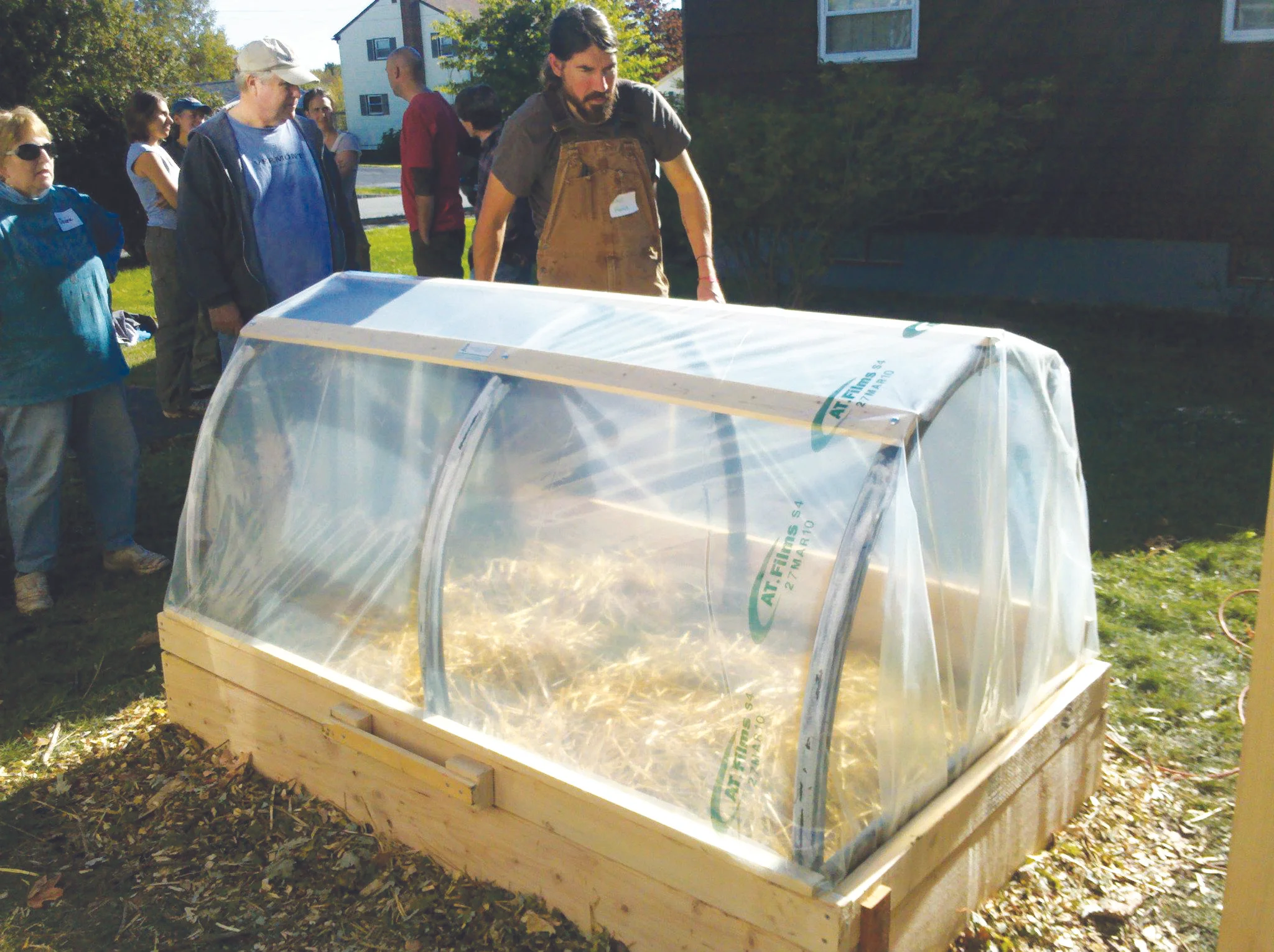Winter Greens: Simple strategies for extending your growing season
Maine’s own four-season gardening gurus Eliot Coleman and Barbara Damrosch, pictured here on their 40-acre Four Season Farm in Harborside. Photo: John Finch
By Lisa Wolff
It's a Saturday afternoon in July and Eliot Coleman is sitting atop his picnic table under a grape arbor on the terrace of his Harborside, Maine farm. He is sipping port wine, wearing felted slipper boots adorned with bright orange carrots, made for him by his neighbor. The fields around him are pregnant with winter storage crops and other produce to store in the farm’s two root cellars for sale at the morning Winter Market at Mainescape in Blue Hill from September through May. When asked what inspired him to get into gardening through the coldest months of the year, he responds, “I didn’t want to give all of my business to the Californians,” with a sparkle of jest in his blue eyes and conviction settled deep in the wrinkles of his ruddy, tanned face. This passion would eventually lead him to become one of America’s grandfathers of four-season farming.
Eliot and his wife, Barbara Damrosch, are both internationally renowned small-scale sustainable farmers and published writers who have been enhancing their sandy soil, planting seeds, covering their crops, and innovating garden tools together on Four Season Farm since the early ‘90s, and Eliot for more than 20 years before that.
Verdant Asian greens, beets, spinach and onions in this Westbrook greenhouse in December, thanks to its double cover design. Photo: Heather Chandler
There is no doubt that Eliot’s ultra-local, radically organic mindset and insatiable inventiveness are what originally inspired famous homesteaders Helen and Scott Nearing (authors of Living the Good Life) to sell him 60 acres of land in Harborside, Maine, for $33 per acre. His commitment to the earth and community would later motivate him to sell 20 of those acres to fellow members of the community for the same $33 per acre. His passion has him constantly modifying gardening tools to improve efficiency for the small farmer. And yet, he is humble in the way he never demands a single patent for the designs that end up for sale in Johnny’s Selected Seeds Catalog.
Eliot’s decades-old instinct to build better local food security during “the other nine months” (October – June) has never seemed more fitting as California institutes drought-induced water rations. Every day, more consumers are becoming increasingly aware of the benefits to reap from the “eat your view” ideology, whether that be eating fresh produce from farmlands you pass on your drive to work or eating from your own backyard.
According to Dave Colson, Agricultural Services Director for the Maine Organic Farmers and Growers Association (MOFGA), only 415 of MOFGA’s 11,000 members are MOFGA Certified Organic farms. The rest are non-certified farms, organic processors, home gardeners, homesteaders and consumers. Two notable trends anecdotally indicate a movement toward home gardening in Maine, said Colson: the average Common Ground Fair attendance of 50,000 - 60,000 people, and growing interest in more education sessions at the fair devoted to season extension.
To eat your view in Maine during the bitter winter months might conjure images of snow cones and ice pops. Maine may get very cold, but the day length – a critical requirement in winter growing – is the same as in Spain or Italy. The reality is that more and more home gardeners are becoming savvy to the fact that, with minimal effort and materials, it is quite simple to extend the season.
Eliot Coleman on his farm in Harborside. Hoop houses (also called a “high tunnel”) like the one in the background are available to homesteaders and home gardeners interested in larger scale garden season extension. Photo: John Finch
Frosty crops in view
The idea of creating additional shoveling responsibilities, as a winter gardener inevitably does, might be enough to stop many from taking the leap into investing in the necessary coverage and crop variety. But the pros substantially outweigh the cons.
“There are no pests, it requires no watering, and there are no weeds. All of the things you are bothered by in the summer are taken care of in winter gardening!” said Coleman. “When planting the last part of your garden, plant Brussels sprouts, kale and leeks. You can be outdoors in Maine harvesting these through Christmas time.”
Also, the sweetest carrots and most delectable spinach are those that are grown in the cold winter months. “We like to call them candied carrots,” said Coleman. “The kids love them. They are the trading items of choice in children’s lunch boxes in the Deer Isle schools.”
For novice winter gardeners, the best vegetables to plant are spinach and carrots because they will have the greatest yield, added Damrosch. Others worth trying are “pick and come again” hardy greens such as kales and Asian greens like bok choy.
“Spinach never goes out of style, even with the big kale renaissance going on,” she said. Barbara’s favorite recipe is wilted spinach with olive oil and grated garlic “just wilted, not steamed.” Coleman intervened to offer his favorite: creamed spinach. Barbara nodded, adding, “You’ve got to use real cream.”
But you don’t have to be a professional farmer to savor the benefits of winter gardening.
Karen Wilson, professor of environmental science and aquatic ecology at the University of Southern Maine, has a self-proclaimed “benign neglect style of gardening” on her 4,000-square-foot “lawn be gone” project in Portland. The goal: “Less lawn and more habitat for anything and every- thing, including me,” she said.
One of her favorite parts of gardening is including her 5-year-old daughter in the process. “She loves to eat kale right out of the garden.” Other cold-hardy crops she enjoys in her extended growing season are perennial sorrel, red Russian kale, mustard greens, claytonia greens and bok choy.
According to Coleman, “One 5’x10’ cold frame can supply one person with vegetables for the whole winter.” And carrots can grow through the winter simply covered with hay and a cold frame. Cold frames are transparent-roof enclosures built low to the ground, functioning as portable mini greenhouses atop a garden bed to to extend the growing season.
Any experienced winter gardener will also tell you that seed quality matters. “Always go with national seed companies based in Maine,” said Coleman, i.e. Johnny’s Selected Seeds in Albion, and Fedco Seeds in Waterville, because their seeds have withstood the test of Maine’s winter growing conditions.
Karen Wilson constructed her hoop house from futon scrap wood to extend the season for growing favorite greens such as kale and sorrel. Photo: John Finch
The secret is in the crop coverage
Beyond seed quality and soil quality – the perennial basics of any productive garden – the greatest learning curve in season extension is covering the crops with an insulating layer. Crop coverage can be as small and simple or large and complex as you like.
“Double coverage” is the best way to extend the season, according to Coleman and Damrosch, who primarily garden year-round in unheated hoop houses (also known as greenhouses and high tunnels). Examples include Reemay (spun bonded polyester fabric) placed about a foot above the crops or straw loosely layered atop plants inside of an unheated hoop house. “It has a polarizing effect that makes it like New Jersey up above and Georgia underneath,” said Coleman. In other words, the temperature is like New Jersey under one layer (the greenhouse itself), and like Georgia under the Reemay fabric or hay.
According to David Homa, owner of Post Carbon Designs, it’s not only how much you cover. “The key to season extension is what you are covering with,” he said, referring specifically to the material over the hoop house. “Is it UV treated and will it hold up in the snow?”
Homa also suggested placing dark stones and dark barrels of water inside your cold frame or hoop house as a way to raise the temperature. These dark surfaces absorb the sun’s heat during the day and radiate it back into the frame through the cold night.
David Homa, of Post Carbon Designs, demonstrates his signature hinged hoophouse which has more ground clearance than other standard cold frame designs, leaving more room for higher-growing crops or a second layer of coverage, such as straw or Reemay. Photo courtesy of Post Carbon Designs
The way Wilson manages her garden through the cold months in Portland is with a 10’x10’ hoop house that she constructed out of futon scrap wood and greenhouse film. Her advice to a first-time winter gardener is to experiment with affixing simple metal conduit hoops over existing raised beds, covered in either greenhouse plastic from FedCo, or even inexpensive construction plastic. “Everyone should give it a try,” she said.
Coleman is also a big fan of do-it-yourself hoop house construction. “You can make a strong hoop house using the top rail used in metal fencing from Home Depot and a hoop bender from Johnny’s Seed Catalog,” he said.
Homa, who also runs the Lakes Region & Western Foothills Permaculture Meetup Group, likes the convenience and height of his distinctive hinged hoop house design. For materials, UV tarps are economical and work great in home gardens. Otherwise, he suggests getting some friends to share the price of a UV roll. Carports can also be easily converted to greenhouses at less cost than a new greenhouse.
If you’re looking to buy a full-sized greenhouse, MOFGA’s Colson suggests those built by Ledgewood Farm in Moultonborough, N.H. They have more rugged frames designed to withstand up to 50 mph winds, he said. “Be sure to build it with the door opening inward,” he added, having learned this the hard way with his first all-season greenhouse.
For winter gardeners itching to expand into wholesale or farmers looking to expand their season, the state of Maine also offers a cost-share grant, administered through the U.S. Department of Agriculture’s Natural Resources Council, to growers who sell a minimum of $1,000 worth of their crops.
The importance of 10-hour daylight
With any winter garden, 10-hour daylight is a critical condition around which to plan, said Coleman.
A good rule of thumb is to have your winter crops grown to 75 percent by the time daylight reaches less than 10 hours. In Maine, this is from Nov. 4 - Feb. 4.
At that time, it’s essentially about converting your garden into a storage room. Crop coverage works like a charm to temper outdoor weather while preserving freshness. The best time to harvest in winter is midday, when any frozen crops have thawed.
Most winter crops are started from mid-July (slow-growing crops such as scallions, chard and parsley, and winter greens such as radicchio) through August (carrots and mustard greens) and September (salad greens such as spinach and arugula).
That doesn’t mean that planting can’t happen in between harvests. Arugula, mâche, spinach, claytonia, radishes and lettuce can all germinate through the winter months.
As for this home gardener, I’ve already ordered my spinach, carrot and kale seeds ready for planting in a few weeks. As you read this I’ll be constructing my hoops. The growers have certainly given me the confidence that, with a little ingenuity, and some crop coverage over my raised beds, I’ll be eating fresh vegetables right through the winter. Wish me luck...
Lisa Wolff ’s writing has appeared in Gourmet News and the Portland Press Herald’s Go magazine. "Winter Greens" ran in the Fall 2105/Winter 2016 issue of Green & Healthy Homes magazine.





